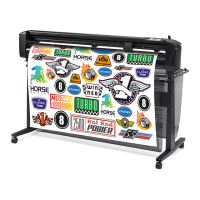4 Cut the substrate
Introduction
Contour cutting is made possible by the highly accurate Optical POSitioning system (OPOS).
The OPOS sensor, which is mounted underneath the tool carriage, detects the various registration marks printed
on the substrate. Using these marks, OPOS can determine the exact position of the printed graphic.
NOTE: This registration process works only with cutting jobs prepared using the software provided.
The sensor drops automatically while registering the markers and rises again after completing this task. The
improved sensor can read virtually any kind of substrate-marker combination.
HP barcode
The HP barcode is the group of elements printed on the substrate to be cut, that allow the OPOS sensor to
identify what cuts should be made and where.
It consists of the following items:
●
Registration marks: Small squares that help the cutter to locate the job accurately, and to compensate for
skew and deformation.
●
Frame: Top and bottom lines that help to compensate for bow deformation and identify the job to be cut.
Automate tasks
During normal OPOS jobs you need only set the tool above the rst mark to start the job. OPOS allows you to
automate certain tasks, thus reducing user intervention and production time. There are several types of
automation.
●
Automatic start of the OPOS job
This is controlled by the parameter OPOS origin. A combination of this parameter setting and/or a special
origin setting during loading of the substrate can mean that you don’t need to set the tool above the rst
mark to start an OPOS job.
●
Multiple copies of the same job
When cutting multiple graphics, you need only maneuver the OPOS sensor above the origin mark of the
rst graphic. You do not need to do this for subsequent graphics.
There are two situations in which this can be done:
–
When cutting multiple graphics, or multiple copies of a graphic, on the same roll of substrate.
–
When cutting the same graphic on multiple sheets of substrate.
ENWW Introduction 23

